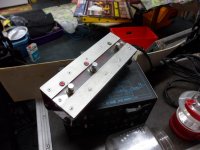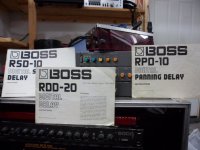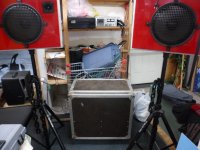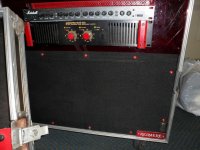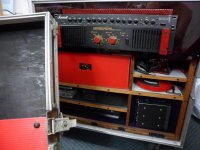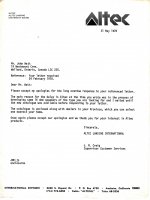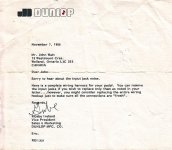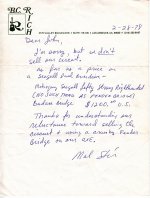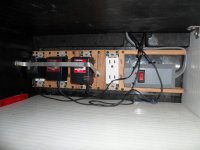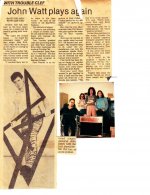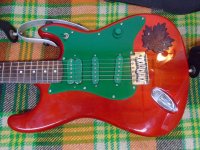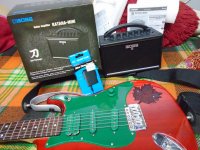I'm showing you the instruction manuals for these BOSS, for me, Roland BOSS products,
more than the three half-rack, micro-digital effects themselves.
I made side plates and screwed them together so they stay that way.
These go through the loop channel on the Marshall pre-amp,
and drain a lot of wattage and voltage, with a drop in ohmage,
with their own negated amperage of creative spacial non-tube ambience.
That's why the panning comes alive with faster or slower stereo spread,
an experience that gets Jimi phasing in to hover over me as I get into it.
Some people just say they see a shadow, others say a ghost,
but I feel a left hand reaching around me.
Please see photos and videos in progressive and general rock.
I use one unit as an always on sweetener echo, helping to sustain every note.
Playing with heavy distortion, I don't even have to push the strings down all the way,
making it all too easy to play fast and use six string transition uh... chords.
It also softens the difference between open and fretted strings,
being able to switch to finger-picking with my inventive guitar.
Going into the second unit, it's built to be an echo unit for special effects.
I turn that on when I need them. Better than an Echoplex or any other echo unit.
I can have a forever echo with no rate, or no vibrato,
where what I play first keeps going, what I play next is on top,
and what I play next starts to fade what I played first.
That's risky, because one wrong note messes it all up,
and you have to turn it off to get away from runaway noise.
It's a good thing that's something I really like to do when I'm playing by myself,
because it takes a lot of practice to get that kind of confidence going.
Both of these units have inputs for other instruments and have other functions,
such as phasing, flanging, you name it, but this is what I use them for.
The panning unit is the same, but I just use it for panning.
Why dilute the electrical strength of the effects I want by adding other signals,
when I've got the original and authentic tones on the floor?
The original owner of Thorold Music, Al, came from a very wealthy family.
He's fifth generation Canadian, his ancestor owning half of Fonthill.
He was repairing a transport truck and cut off half of his thumb,
so he thought he'd take it easy and start a music store, playing stringed instruments.
He phoned me up one day and said he had some strange equipment that was very expensive,
and he thought I was the only guitarist who might be interested.
Hey! I never did get married or have children, and I'm not rich,
but I get to spend all my money on myself... most of the time.
He just got the Roland-BOSS franchise, and felt stuck with what could be prototype models.
They were $525 each with taxes, and there was a fourth model.
It was designed to be mounted on a wall for residential applications,
turning on your TV and other components, controlling them all.
As soon as I saw what they did and how they sounded, even quiet in the store,
I wanted to try them with my Marshall and Audio Pro. Incredible, hearing them for the first time.
It's still incredible, having a sound that turns me on almost as much as my playing.
The ambient environment they create with the floor effects is a duality for stereo ears.
I have never taken these out to use for a gig, as new, with only experimental hours on them.
Now I'm ready to let loose with all of this system with my semi-solid-body guitars.
The local cable news provider said I could have two minutes of news time,
the first time I show up and play with them in public.
If you play bass onstage, wouldn't you like to share in that?
If I'm not in a band, a dance band that can jam it up, I'm nowhere.
The second photo shows the foot-switch I built for the three BOSS units.
The translucent plastic, or rubylith, was custom ordered from GM in the disUnited States.
A Ferrari dealer in Toronto found it less expensive to order this plastic from a sign-maker,
and have him make tail-lights out of it instead of ordering from Italy.
When I heard that I asked if giving me a piece could be part of the deal.
The LEDs, used to show when the function is on, light up the pedal,
so I can see it in the dark and have more red for the total display.
Those are double-throw switches that cost $15 each wholesale in 1977,
custom ordered by my friendly music store from the United States.
A product used for manufacture, I could have both effects and LEDs work at the same time.
The green light is for the panning, always on, and acts as a guide in the dark.
I've got a mike stand with tripod legs, and put this pedal up against the upright,
so it's right there in front of me, but out of the way, just using it for the special echo effect.
Being able to take them out of the case and put them on top of my amplifier,
makes it easy to change the settings for the echo onstage.
Considering what other echo effects did for recording acts I was doing songs by,
I usually just set it for ordinary echo effects and left it at that.
Doing my own soundchecks onstage let me get into the deep stuff.
I have never heard another guitarist with the same sonic and tonal effects this allows.
And I don't care if I say I can make sounds like Jimi Hendrix,
and riff out like John Coltrane and George Benson to Nicolo Paganini,
when no-one has ever disagreed,
because I don't want to waste my time recording for artificial reasons,
or have to be in bands that use presets, tapes and prerecorded or looped song parts,
because when you're dancing or moving around with the music,
grooving with the dance floor, jumping offstage to get into it with the dancers,
you want all the freedom in this whirled, this world of rotating disco balls,
swirling lights and stereo sounds... getting down and floating above everyones' heads...
turning everyones' heads... getting into their heads and panning your sounds between their ears...
as my notes disappear into the air... as my voice does...
not as delete-able as this font... but processed almost the same...
from my brain to yours... as right as rain and as left as receding tides.
Not the Axis of Sound that Jimi Hendrix stood in, with his quadrophonic P.A.,
but the eye of a melodic hurricane that you can walk inside as it travels along,
being carried up in the spirit... as the night ends and the sound rises up and away...
until another day... and another night... when your love is there for you to see.
Plug your guitar into my amplifier system and generate your own cloud pattern...
let your riffs create your own lightning... let the motion of your guitar create more sound...
and... and... guess what?
With all amplifier volumes on full, standard operating procedure,
with my guitar volume off,
I can hold my guitar up to a speaker and not hear any sound at all,
and playing onstage, it was weird at first, that total silence, until I turned it up.
there once was a boy whose heart was a frown,
'cause he saw Jimi Hendrix and couldn't afford all that sound,
until one day, when he decided to try...
so he took his guitar to a big music store,
and to his amp he said you won't disappoint me no more.
But suddenly, some effects he never seen before came his way,
making him jump up and riff away,
and they didn't have to stop, they just kept on going...
and so hassles of left hands slip into the scene... eventually.
May All Peace Be Upon You.
